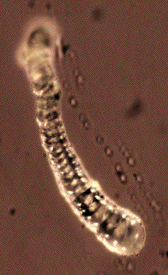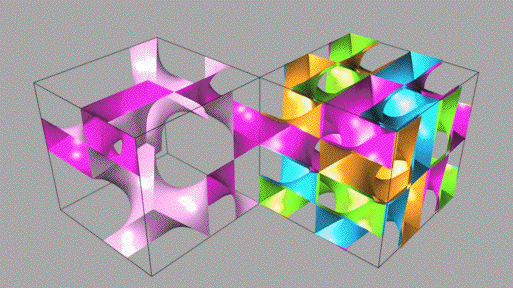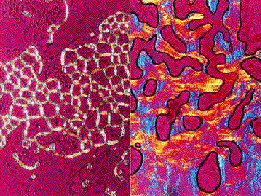






Abstract:
We explore a novel method to generate and characterize complex networks by means of
their embedding on hyperbolic surfaces. Evolution through local elementary moves allows the
exploration of the ensemble of networks which share common embeddings and consequently
share similar hierarchical properties. This method provides a new perspective to classify
network-complexity both on local and global scale. We demonstrate by means of several
examples that there is a strong relation between the network properties and the embedding
surface.
Abstract:
We propose a general method to study the hierarchical organization of financial data.
The statistical, geometrical and topological properties of such data are analyzed by
embedding the structure of their correlations in metric graphs in multi-dimensional
spaces. We show an application to two different sets of interest rates data. In this
case we construct triangular embeddings on the sphere. The resulting graph contains
the minimum spanning tree as sub-graph and it preserves its hierarchical structure.
This results in a clear cluster differentiation and allows to compute new local and
global topological quantities. A three dimensional representation of this embedding
is constructed together with its projection on a plane by using the Pelting method
and a relaxation procedure to converge on the correct metric geometry.

[Also available at LANL archive].
Abstract:
Abstract:
We investigate the wealth evolution in a system of agents that ex-
change wealth through a disordered network in presence of an additive stochastic
Gaussian noise. We show that the resulting wealth distribution is shaped by the de-
gree distribution of the underlying network and in particular we verify that scale free
networks generate distributions with power-law tails in the high-income region. Nu-
merical simulations of wealth exchanges performed on two different kind of networks
show the inner relation between the wealth distribution and the network properties
and confirm the agreement with a self-consistent solution. We show that empirical
data for the income distribution in Australia are qualitatively well described by our
theoretical predictions.
Abstract:
Many crystalline networks can be viewed as decorations of triply periodic minimal surfaces.
Such surfaces are covered by the hyperbolic plane, in the same way that the euclidean
plane covers a cylinder. Thus, a symmetric hyperbolic network can be wrapped onto an
appropriate minimal surface to obtain a 3d periodic net. This requires symmetries of the
hyperbolic net to match the symmetries of the minimal surface. We describe a systematic
algorithm to find all the hyperbolic symmetries that are commensurate with a given
minimal surface, and the generation of simple 3d nets from these symmetry groups.
Abstract:
We describe self-assembled silica-carbonate aggregates that show a diverse range of
morphologies, all of which display complex internal structure, orientational ordering
of components, and well-organised, curved global morphologies that bear a strong
resemblance to biogenic forms. The internal order is described as a liquid-crystallike
organisation of colloidal particles. We discuss possible causes for the striking
morphologies of these inorganic materials, including local nanocrystal packing constraints
and global silica membrane templating.
Abstract:
This article presents a medial surface analysis of the rhombohedral infinite periodic
minimal surface rPD. This one-parameter family of labyrinth-forming, bicontinuous
surfaces has been suggested as a continuous pathway for transitions between its
two cubic members, the Primitive and the Diamond surface, e.g. in mesophases in
liquid-crystalline self-assembly processes. By providing a definition of a pointwise
channel diameter, the MS allows for the analysis of packing properties, stretching
frustration and homogeneity of such surfaces that cannot be deduced from curvature
characteristics alone. The medial surface (MS) is a representation of a labyrinth
structure as an embedded and centered 2D skeleton, and is a geometrically equivalent
description of the labyrinth as the labyrinth itself. It can be further reduced to a
well-defined 1D line graph. For the rPD surface, we show that variations of the channel
diameter are locally minimal for the member corresponding to the D surface,
and a horizontal inflection point in the case of the P surface. This may have implications
for the phase stability of corresponding liquid-crystalline mesophases. We also
demonstrate that a 1D line graph, if geometrically centered within the labyrinth,
contains curved edges and cannot be deduced from symmetry considerations alone.
Abstract:
Small angle x-ray (SAXS) scattering and 14N NMR relaxation were determined for microemulsion samples formed from didodecyl dimethyl ammonium bromide (DDAB), water and tetradecane to deduce the associated microstructures. The swelling features within the tetradecane microemulsion are unusual compared with DDAB/water/alkane analogs formed with shorter n-alkanes: tetradecane-containing microemulsions do not show the characteristic anti-percolation transition seen for the latter microemulsions. Experimental data along tetradecane dilution lines are consistent with a continuous transition from a bilayer to monolayer structure of the surfactant interface. The evolution is topologically complex. It involves the annealing of bilayer punctures that occur on oil dilution. A quantitative model that allows continuous transformation from multihandled bilayers (typical of L3 sponge mesophases) to multi-handled monolayers (typical of microemulsions modelled with shorter chained alkanes) is proposed that fits well the observed behaviour.
Abstract:
A variety of life-like "biomorphs" can be grown by co-precipitation of silica
and alkaline-earth carbonates at high pH. Forms include twisted filaments
and sheets, that are indistinguishable from microscopic inclusions in
ancient rocks, commonly identified as ancient microfossils. Biomorphs are
spectacular examples of self-assembled inorganic colloids, forming
composites of nm-sized rod-shaped carbonate nanocrystals and colloidal
amorphous silica spheres. The structural complexity of these materials, with
orientational and translational order/disorder at distinct length scales, is
reminiscent of many hard biomaterials, such as bone.

* -- National Center for Science Education, http://www.ncseweb.org, S -- Project Steve "Steve", http://www.ncseweb.org/article.asp?category=18, N -- Nobel laureate, % -- Appeared on The Simpsons, $ -- Ordered 16 Project Steve t-shirts in order to outfit all of the staff in his lab, ! -- Not to be confused with the preceding Steve with the identical name.
"The Morphology of Steve", Annals of Improbable Research, July-August (2004)

Abstract:
This report is part of Project Steve. Project Steve is, among other things, the first scientific analysis of the sex, geographiclocation, and body size of scientists named Steve. We performed this research for the best of all reasons: we discovered that we had lots of data. No scientist can resist the opportunity to analyze data, regardless of where that data came from or why it was gathered.
Abstract:
We have synthesized inorganic micron-sized filaments, whose microstucture
consists of silica-coated nanometer-sized carbonate crystals, arranged with
strong orientational order. They exhibit noncrystallographic, curved, helical
morphologies, reminiscent of biological forms. The filaments are similar to
supposed cyanobacterial microfossils from the Precambrian Warrawoona chert
formation in Western Australia, reputed to be the oldest terrestrial microfossils.
Simple organic hydrocarbons, whose sources may also be abiotic and indeed
inorganic, readily condense onto these filaments and subsequently polymerize
under gentle heating to yield kerogenous products. Our results demonstrate
that abiotic and morphologically complex microstructures that are identical to
currently accepted biogenic materials can be synthesized inorganically.
(see also comments in Science (News of the Week), 302, 1134, 2003; see also New Scientist, 22 November, 14-15, 2003; Chemical & Engineering News,17 November, 58, 2003.)
Abstract:
We introduce a robust algorithm for numerical computation of a medial surface and an associated medial graph for three-dimensional shapes of arbitrary topological and geometric complexity, bounded by oriented triangulated surface manifolds in three-dimensional Euclidean space (domains). We apply the construction to particularly complex ``bicontinuous'' domain shapes found in molecular self-assemblies, the cubic infinite periodic minimal surfaces of genus three: Gyroid (G), Diamond (D) and Primitive (P) Surfaces. The medial surface is the locus of centers of {\em maximal spheres} wholly contained within the domains, i.e.~spheres which graze the surface tangentially and are not contained in any other such sphere. The construction of a medial surface is a natural generalization of Voronoi diagrams to continuous surfaces. The medial surface algorithm provides an explicit construction of the bounding surface patch associated with a volume element, giving a robust measure of surface to volume ratios for complex forms. It also allows for sensible definition of a line graph (the medial graph), particularly useful for volumes consisting of connected channels, and not reliant on symmetries of the volumes. In addition, the medial surface construction produces a length associated with any point on the surface. Variations of this length give a useful global measure of homogeneity of the volumes. Comparison of medial surfaces for the P, D and G surfaces reveal the Gyroid to be the most homogeneous of these cubic bicontinuous forms (of genus three). This result is compared with the ubiquity of the G surface morphology in soft mesophases, including lyotropic liquid crystals and block copolymers.
Abstract:
We demonstrate the usefulness of two-dimensional hyperbolic geometry as a tool to
generate three-dimensional Euclidean (E3) networks. The technique involves projection
from tilings of the hyperbolic plane (H2) onto three-periodic minimal surfaces, embedded
in E3. Given the extraordinary wealth of symmetries commensurate with H2, we can
generate networks in E3 that are difficult to construct otherwise. In particular, we form
four-, five- and seven-connected (E3) nets containing three- and five-rings, viz. (3,7),
(5,4) and (5,5) tilings in H2. These examples are of fundamental interest, as they present
"topological symmetries" that are incompatible with the isometries of E3.
Abstract:
We describe a technique for construction of 3D Euclidean (E3) networks with partially-prescribed rings. The algorithm starts with 2Dhyperbolic (H2) tilings, whose symmetries are commensurate with the intrinsic 2D symmetries of triply periodic minimal surfaces (orinfinite periodic minimal surfaces, IPMS). The 2D hyperbolic pattern is then projected from H2 to E3, forming 3D nets. Examples of cubic and tetragonal 3-connected nets with up to 288 vertices per unit cell, each linking a pair of 6-rings and a single 8-ring, are derived by projection onto the P, D, Gyroid and I-WP IPMS. A single example of a projection from close-packed trees in H2 to E3 (via the D surface) is also shown, that leads to a quartet of interwoven equivalent chiral nets. The configuration describes the channel system of a novel quadracontinuous branched minimal surface that is a chiral foam with four identical, open bubbles.
Abstract:
Recent developments in theoretical and experimental studies of amphiphilic lyotropic "intermediate" mesophase formation are summarized. For the purposes of the review, we consider intermediate mesophases to be self-assemblies with novel geometries and topologies, excluding lamellar, sponge, columnar (hexagonal) and micellar mesophases. Intermediates include novel branched bilayer topologies &endash; enclosing multiple interwoven channel systems and inclined rod packings &endash; and punctured bilayer morphologies, including mesh phases and bicontinuous monolayers.
Abstract:
This paper deals with the difficulty of decoding the origins of natural structures through the study of their morphological features. We focus on the case of primitive life detection, where it is clear that the principles of comparative anatomy cannot be applied. A range of inorganic processes are described, that result in morphologies emulating biological shapes. We focus on geochemically plausible processes, in particular, the formation of inorganic biomorphs in alkaline silica-rich environments, which are described in detail.
Abstract:
Interpenetration (catenation) has long been considered a major impediment in the achievement of stable and porous crystalline structures. A strategy for the design of highly porous and structurally stable networks makes use of metal-organic building blocks that can be assembled on a triply periodic P-minimal geometric surface to produce structures that are interpenetrating--more accurately considered as interwoven. We used 4,4',4"-benzene-1,3,5-triyl-tribenzoic acid (H3BTB), copper(II) nitrate, and N,N'-dimethylformamide (DMF) to prepare Cu3(BTB)2(H2O)3·(DMF)9(H2O)2 (MOF-14), whose structure reveals a pair of interwoven metal-organic frameworks that are mutually reinforced. The structure contains remarkably large pores, 16.4 angstroms in diameter, in which voluminous amounts of gases and organic solvents can be reversibly sorbed.
see also Comment by Ferey in Science.
Summary:
The Chapter is a comprehensive account of the current state of awareness of lyotropic liquid crystalline mesophases, including lamellar, cubic (bicontinuous and discrete), hexagonal and intermediate mesophases, as well as sponge phases and microemulsions. The emphasis is on a rigorous identification of the bilayer topology . Some discussion of possible &endash; as yet unknown &endash; novel mesophases is present. The chapter also contains a survey of practical techniques to identify distinct meophases in the lab, including SAXS, optical microscopy and other techniques.
Abstract:
We describe a construction procedure for polycontinuous structures, giving generalisations of bicontinuous morphologies to more than two equivalent, continuous and interwoven sub-volumes. The construction gives helical windings of disjoint graphs on triply periodic hyperbolic surfaces, whose universal cover in the hyperbolic plane consists of packed, parallel trees. The simplest tri-, quadra- and octa-continuous morphologies consist of three $(8,3)-c$, four $(10,3)-a$ and eight $(10,3)-a$ interwoven networks respectively. The quadra- and octa-continuous cases are chiral. A novel chiral bicontinuous structure is also derived, closely related to the well-known cubic gyroid mesophase.
Abstract:
A method is developed to construct and analyse a wide class of graphs embedded in Euclidean 3D space, including multiply-connected and entangled examples. The graphs are derived via embeddings of infinite families of trees (forests) in the hyperbolic plane, and subsequent folding into triply periodic minimal surfaces, including the P, D, gyroid and H surfaces. Some of these graphs are natural generalisations of bicontinuous topologies to bi-, tri-, quadra- and octa-continuous forms. Interwoven layer graphs and periodic sets of finite clusters also emerge from the algorithm. Many of the graphs are chiral. The generated graphs are compared with some organo-metallic molecular crystals with multiple frameworks and molecular mesophases found in copolymer melts.
Abstract:
Many complex crystalline 3-dimensional graphs are of interest to solid-state chemists, in order to relate atomic and molecular crystal structures.Some of those graphs can be generated from tessellations of the 2d hyperbolic plane, and then mapped onto triply periodic hyperbolic surfaces. The properties of such graphs, including their densities, can be analyses in terms of topological and non-euclidean geometric concepts. Examples include a variety of zeolite frameworks and novel graphitic carbon structures.
Abstract:
Although the primitive (P), diamond (D) and gyroid (G) minimal surfaces form the structural basis for a multitude of self-assembling phases, such as the bicontinuous cubics, relatively little is known regarding their geometrical transformations, beyond the existence of the Bonnet isometry. Here their highest symmetry deformation modes, the rhombohedral and tetragonal distortions, are fully elucidated to provide a unified description of these simplest minimal surface families, with all quantities expressed in terms of complete elliptic integrals. The rhombohedral distortions of the gyroid are found to merge continuously with those which bridge the P and D surfaces, furnishing direct transformations between all three cubics, preserving both topology and zero mean curvature throughout. The tetragonal distortions behave analogously, offering an alternative route from the gyroid to the D surface. The cell axis ratios, surface areas and Gaussian curvature moments of all families are given, supplying the necessary geometrical input to a curvature energy description of cubic and intermediate phase stability.